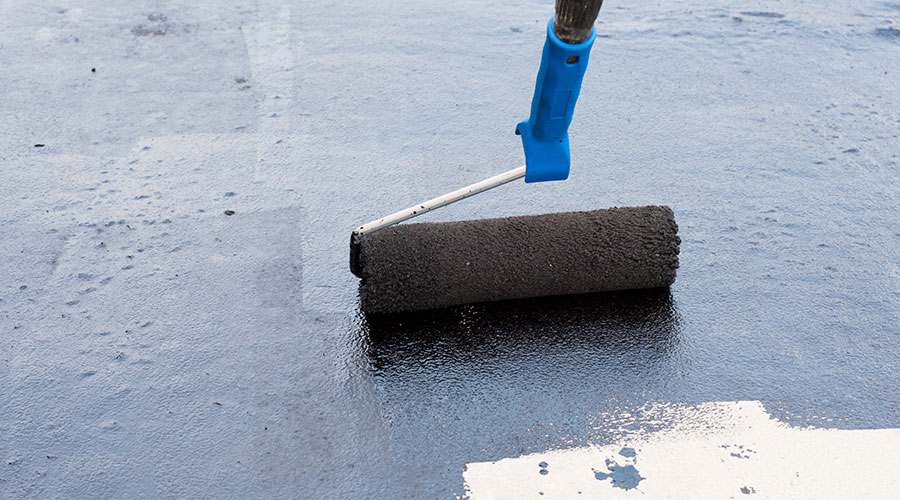Why Roof Coating Success Starts with Preparation
Managers should ensure that technicians conduct a thorough roof-condition assessment to determine if the existing roof system is a good candidate for coating.
Managers must also be aware that substrate suitability for receiving a coating system application is an important consideration, along with any required modifications to the substrate to provide a surface to which a coating may be applied.
“Sometimes an existing surface is unsuitable for a coating application, and a suitable material may be fastened or applied to the existing substrate to meet the manufacturer’s substrate requirements for the coating application,” Hnatiw says.
Adhesion depends on surface preparation, she says, “whether it be a metal surface ground to bright metal, a concrete surface roughened to meet (Society for Protective Coatings) requirements, or removal of debris, grease or any loose or any foreign matter on the substrate that would adversely affect coating adhesion.”
A thorough roof evaluation provides data that drives decisions when selecting the correct system and establishing an effective roofing plan.
“The key to any good roofing project comes down to a few fundamental steps,” says Josh Poole, board president of the Roof Coatings Manufacturers Association (RCMA) and director of Product Management at Tremco CPG Inc. “This especially holds true when it comes to roof restoration utilizing roof coatings.
“Proper installation helps the end user realize the expected performance of the roofing system. Routine maintenance maximizes the long-term performance of the roofing system during its service life. By following these steps, you can create a roofing plan that aligns with the lifespan of the building in many cases.”
Poole says managers and technicians can access RCMA’s virtual training program, which underscores the danger of neglect.
“Lack of maintenance and upkeep can lead to premature degradation and breakdown of the roofing system,” he says. “Choosing established contractors and manufacturers “can be the difference between a good project and a bad one.”
To ensure a coatings application succeeds, RCMA recommends several steps that managers should take:
- Planning and documentation. Gather and review all key product documents — including product data sheets, safety data sheets, project specifications and detail drawings — before work begins. Resolve discrepancies with stakeholders early. Establish staging areas, check equipment, stock consumables, and hold daily safety and start-up meetings to align tasks and site conditions.
- Roof evaluation. Conduct a full rooftop inspection of penetrations, flashings, seams, drains, signs of wear and areas with heavy foot traffic. Use infrared cameras or moisture detectors to reveal hidden moisture or trapped water in the deck or insulation. Determine if repairs or full replacement are needed and map all areas requiring attention.
- Surface preparation. Clean, dry and clear the roof of debris. Power washing the roof at low pressure is common, but technicians must follow manufacturer’s guidance. Perform mechanical preparation, such as grinding and blasting for concrete or metal substrates, where needed. Repair seams, flashings and penetrations. Three-coursing, or sealant plus reinforcing fabric, is common for seams and fasteners. Conduct adhesion tests to confirm the substrate is ready for coating.
- Application and quality control. Follow manufacturer instructions for primers, basecoats and topcoats, observing correct coverage rates and mil thickness. Apply base and topcoats in perpendicular — cross-rolled — directions to ensure even coverage and avoid pinholes. Use white-glove tests, wet mil gauges and coverage checks during installation for quality assurance.
- Post-application and maintenance. Allow full curing before traffic. Perform touch-ups using the same coating system as needed. Implement a routine maintenance plan that includes regular debris removal, inspection after severe weather and timely repairs of cuts, punctures and blisters.
Other situations managers should be aware of when technicians start a coatings job include:
- overapplication or underapplication of coatings, which can cause weak protection, cracks or improper curing
- ignoring manufacturer guidance, such as using the wrong primer, mixing ratios or application equipment resulting in adhesion or cohesion failures
- not performing adhesion or wet mil checks during the application, resulting in defects.
Surface preparation
Preparing the surface is the most critical component of the coating application process.
“After the repairs are completed, the roof area must be properly cleaned of all debris, loose materials and containments prior to the coating application,” says John D’Annunzio, president of Paragon Roofing Technology, a roofing consulting firm.
Waterproof protection is also important when specifying coatings.
“Although coatings can extend the service life of the roof system, most of them do not provide long-term, stand-alone waterproofing protection,” D’Annunzio says. “Therefore, proper repairs to deficiencies in the existing roof material are required prior to the coating application. Proper repairs are required on the entire system, and include removing all wet insulation, repairing all openings and replacing all deteriorated membrane or flashing materials.”
The application process should comply with the manufacturer’s requirements. Most roof coatings have temperature constraints, meaning managers must make certain the materials are properly stored prior to application.
“The application should be completed within the material’s proper temperature requirements,” D’Annunzio says. “Cold weather application can lead to loss of adhesion, and hot weather application can lead to improper curing of the material. Check the forecast prior to application, as some roof coatings cannot be applied within 24 hours of precipitation like rain, snow and ice.”
While there have been significant technological advances in coatings, D’Annunzio says they still have limitations.
“Facility maintenance engineers and managers should understand that coatings are primarily restoration materials that can extend the service life of roof systems,” he says. “However, if the existing roof system is at the end of its service life, then coatings will only be a short-term solution.”
Managers should ensure that technicians conduct a thorough roof-condition assessment — including moisture analysis — to determine if the existing roof system is a good candidate for coating.
“The performance of the roof coating will only be as good as the condition of the roof system it is applied over,” D’Annunzio says.
Howard Riell is a freelance writer based in Henderson, Nevada.
Related Topics:













